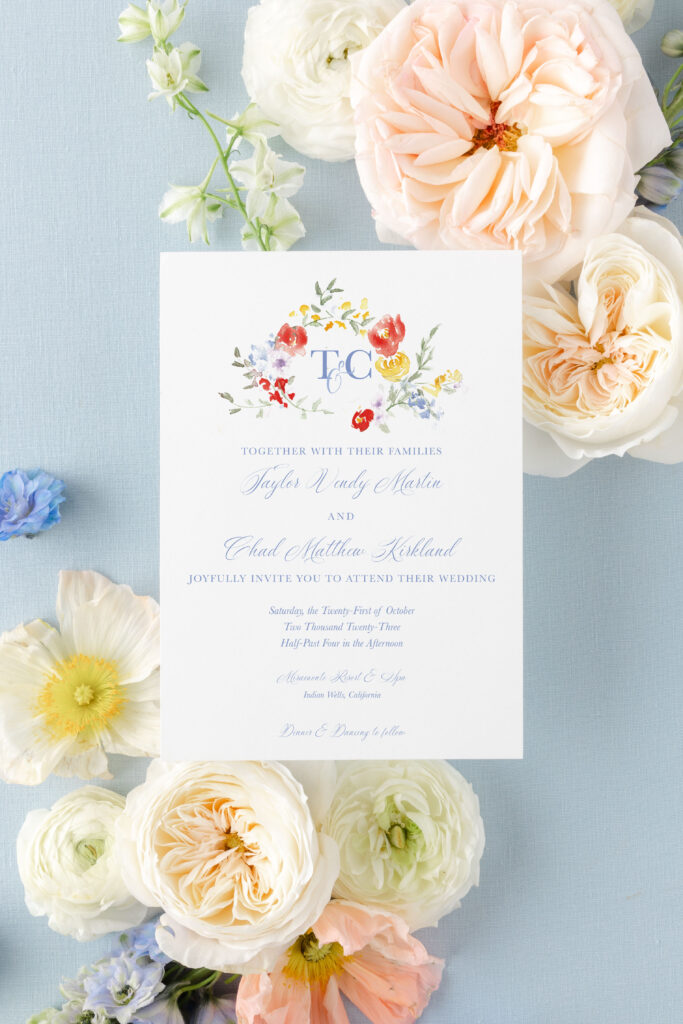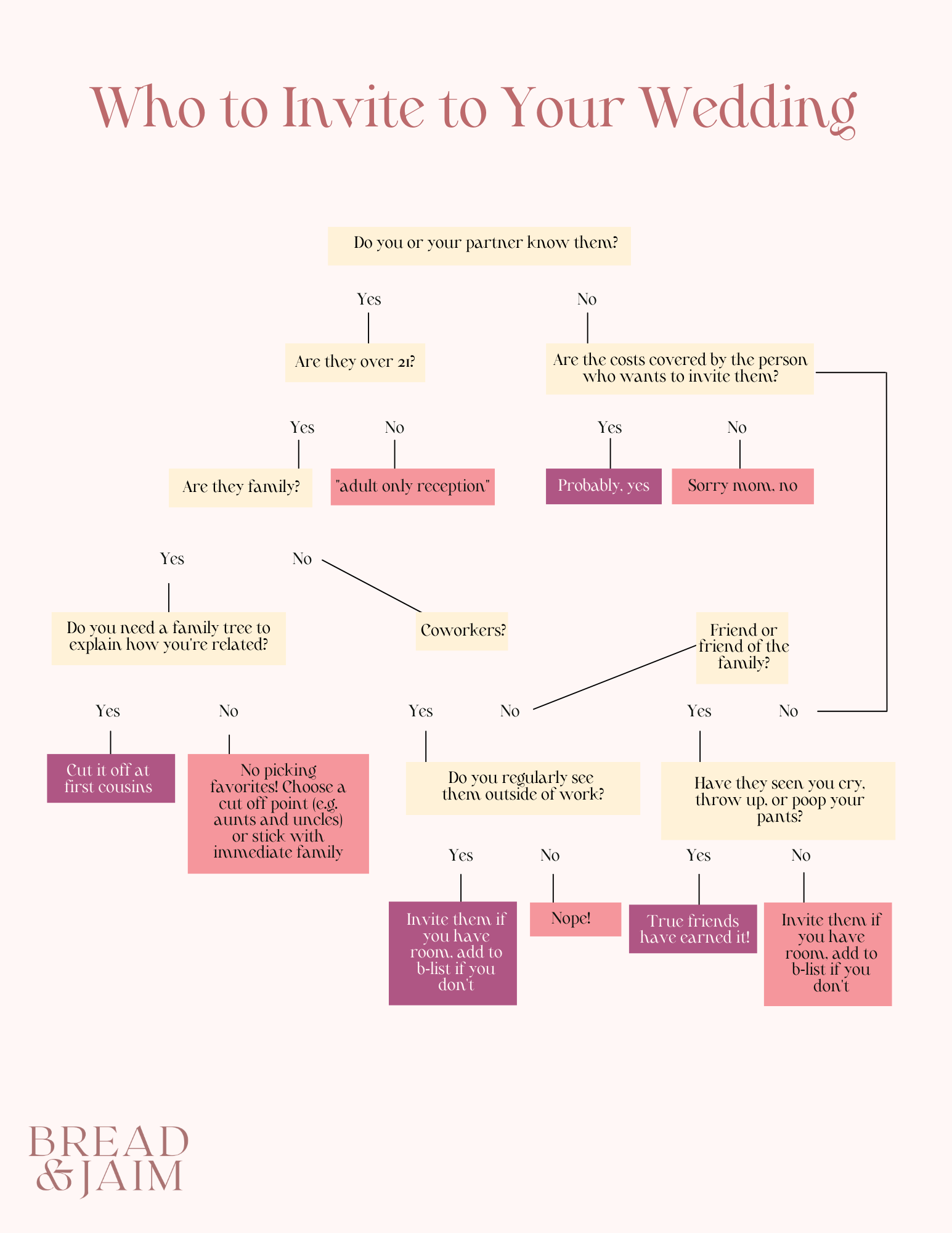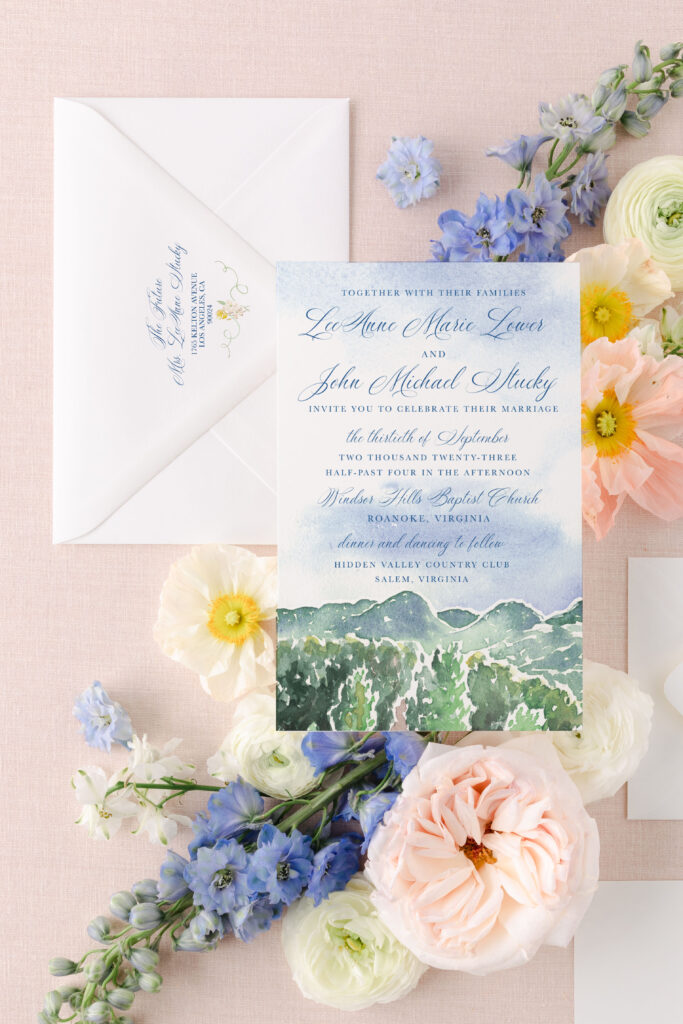Who should you invite to your wedding? A handy flow chart.
August 10, 2024
Planning a wedding is stressful enough without having to make tough decisions about a guest list. As a recent bride, I remember how difficult the choices can be when you’re trying to stick to a certain guest count that’s dictated by your venue or budget. And now several years later, there are still people who I wish I invited to my wedding, or people I am no longer close to that didn’t need to be there. So how do you choose? Are you staring at a guest list of 300 people and wondering how to cut it down? As a professional stationery designer, and wife of 7+ years, I’m here to help. Check out my guide and use the handy flow chart to make your choices just a little bit easier!

Ultimately, who you decide to invite to your wedding is a personal decision, but it’s also informed by what’s expected in your culture. In the U.S. the average wedding size is over a hundred people – 115-125 on average depending on the statistics. In Europe, weddings tend to be a little smaller. In Latin American or Indian cultures, it’s a cultural norm to invite more of the extended family, family friends, or even neighbors making the weddings even larger. The average for India was 524 people, for example. Talk about an easy guest list to create (everyone you know gets an invite!) but hard to plan for.
If your list of family and friends is small, you might think 100 people is pretty large and you can’t imagine inviting close to that number to your wedding. But if your family is on the larger side, or your fiance has a ton of friends, it can be harder to decide who stays and who goes. This is the situation I was in.
My extended family is pretty large. My mom is one of seven children so I have a ton of Aunts, Uncles, and Cousins. My now husband, was in a fraternity in college that he’s still very active in, so he had a ton of friends. Our venue had a strict limit of 150 so we were definitely nervous that our RSVPs would come in and we would be over the limit.
I’m basing my advice on what is typical in a traditional American wedding, so you may want to adjust your plans according to your traditions and culture.
Looking for more advise on sending out wedding invitations? Try this article on 5 things you shouldn’t do when sending out wedding invites.
Here’s my decision flow chart to help decide who is in and who is out.

What it comes down to is how close you and your significant other are to the other person. If you would invite them to go grab drinks on the weekend, or they’ve seen you in a vulnerable moment, then you should probably include them! If you aren’t sure you’ll see them otherwise for the next decade, then you can probably skip them.
Now for some commonly asked questions.
Do I have to invite all of my family to my wedding?
No, you don’t need to invite every family member to your wedding. You can choose a cut off point and anyone outside of that circle doesn’t get invited. For example, the cut off point can be by layer (e.g. first cousins vs second cousins) or by age (e.g. everyone over 18 or 21).
This can be less cut and dry if you are closer to certain extended family members. To keep it fair, if you invite one person from that layer, you should try to account for the entire layer. For example, if you invite one cousin, you should invite them all. Second cousins or once-removed can be the cut off point. Or if you invite your uncles and aunts on your Dad’s side then you should invite the ones on your Mom’s side and your partners’ aunts and uncles too. There are always exceptions to this rule but it’s a good way to try to ensure fairness.
For my wedding, I invited all of my cousins, but I didn’t invite my cousins’ kids even though some of them were old enough to be invited. If I had included my cousins’ kids that would’ve opened up a whole new layer of invitations and I would’ve needed to consider adding another 10-15 people. That’s a whole additional table!
If your parents are divorced and remarried, this can be even trickier. Ask your parents for guidance navigating if you’re stuck. One way is to cut this off at blood relatives, or relatives you’ve known for a longer time period. You don’t need to invite your step mom’s sister, brothers, nieces and nephews if you’ve never met them or your step mom joined the family a short time ago. But if those people watched you grow up and were as close to you as any other aunt, uncle or cousin in your family, then you should consider a way to include them. You may need to cut it off at aunts and uncles from each side to stay within your guest count, or only invite immediate family members.
Do I have to invite my parents’ friends to my wedding?
If your parents are paying for your wedding, it’s bound to come up in wedding planning that they have certain people they would like included. Or your parents might have guests they would like on the list even if they’re not contributing any funds.
You don’t have to include your parents’ guests in your wedding day. But if you’re parents are paying for it, they may feel like they have more of a say in the planning and you should consider honoring their requests. Your parents might even make it a condition of the money they are providing.
Generally, I’ve seen that for larger weddings where parents are paying for a significant portion of the event, the couple’s parents include friends, coworkers, bosses, and even key clients on the invitation list. Your parents are hosting a big party and it’s a great excuse for them to get everyone they know together to catch up and have fun, or even to impress them with how extravagant the party is and pamper VIP guests.
If your parents aren’t chipping in financially, it’s easier to say no to your parent’s requests to add on to the guest list. If your parents still insist that you invite someone, ask them to contribute the extra amount that would be needed to host them including extra invitations, favors, food costs per plate, and other decor items if it requires a new table to be made.

Is it rude to not invite someone’s spouse to a wedding?
Yes. There is almost no circumstance I can think of where you would invite someone as a guest to your wedding and not extend the invitation to their current spouse. Obviously if they are separated or experiencing marital trouble, one of them might not attend and you should leave that decision up to the couple in question to decide. Don’t butt into their affairs over the potential guest list.
If the spouse is a trouble maker or there’s drama there, just exclude the whole couple. When two people are married, they are a unit. It’s extremely difficult to stay friends with someone if you don’t like their spouse.
This logic extends to your seating chart as well. Don’t split up spouses, engaged people, or dating couples among different tables. I can guarantee that you’re ruining someone’s night if their significant other is seated at the head table and you seat them at a table with the rest your family or friends. I’ve had this happen to me and it’s extremely uncomfortable. It causes people to not stay at their tables since they want to be with their spouse or significant other for the night.
Do I need to invite plus ones to my wedding?
No, you don’t need to automatically give everyone a plus one to your wedding. Here are some general rules of thumb when it comes to plus ones.
If two people have been dating more than a year and it’s serious, you should send them both an invite. If you want a stricter cut off, you can have a hard line that only engaged people or married people get a plus one. But don’t change up the rule based on who it is. You have to commit to the rule across your guest list otherwise it looks like you’re playing favorites.
You don’t have to give plus ones just because someone asks you for one. Simply respond with what your cutoff rule is and blame the venue capacity limits.
It’s very simple to share with guests whether they are receiving a plus one or not on the invitations. First, on the invitation envelope, address it to “Mr. Smith and Guest” or simply “Mr. Smith” based on whether they have a plus one or not. Plus ones, get “any guest” or the name of the guest if you know who it is already. Second, indicate on the RSVP card or website how many people they are allowed to RSVP for. So you can write “2” for a person with a plus one or a couple, or “1” for a single person without a plus one.
How do you tell someone they’re not invited to your wedding?
It happens to the best of us. There’s an extended family member, coworker, acquaintance or even a friend who assumes they are invited to your wedding but they actually didn’t make the cut.
If someone isn’t invited to the wedding, you should tell them directly with a reasonable explanation. Or if you’re unsure if they will be invited, you can let them know you’re still working on the guest list.
To politely break the news, be direct and factual. Usually an explanation that your wedding venue restrictions or budget restrictions put a cap on the amount of people you could invite is enough. You can say something like “Oh, Janet! While I’d love to have you there, we had to make some difficult cuts. Tt is unfortunately out of my budget to have more than 100 guests.” Or, “my venue doesn’t allow more than 100 guests so we had to keep the guest list small.”
Here are a number of reasons to point to that are easy to understand:
- You both have large families
- Your parents are paying for the wedding and in control of the guest list
- You’re trying to keep the wedding small and intimate
- You’re paying for the wedding yourself and have to keep to a small number
- Budget restrictions
- Your dream venue has a capacity limit
- You only invited people you see outside of work regularly (for coworkers / acquaintances specifically)
- You didn’t invite anyone from book club / soccer / work / cousins / etc. (only if this is true!)
Make sure you don’t outright lie to the person. If you tell them your wedding is small but it’s 300 people, they will find out. Better to say you have a larger than average guest list and had to make difficult cuts to keep it within budget.
If you’re on the fence about them, or they just didn’t quite make the cut because you had to include other relatives first, let them know that you haven’t finished your guest list yet and you’ll let them know when the invitations go out. Then you can add them to a b-list and send them an invitation after you hear back some no’s to your RSVPs. They will get the invitation a little later than the rest of the group but you’re still likely going to be able to accommodate them.
If it turns out that you still can’t invite them, please let them know that it unfortunately didn’t work out. Refer to the above reasons for some help with explanations.
Looking for more wedding wording advice? Try this blog post on wedding invitation wording.
Summary
Planning a wedding can be overwhelming, especially when it comes to making tough decisions about the guest list. Drawing from personal experience as a recent bride and a professional stationery designer, this guide offers practical advice on how to navigate the challenges of trimming your guest list. Whether you’re grappling with cultural expectations, large families, or budget constraints, my handy flow chart will help you determine who makes the cut. It also addresses common dilemmas like inviting extended family, plus ones, and handling awkward conversations with those who didn’t make the list, ensuring you can make these decisions with confidence.
Still need help? Schedule a free consultation to talk through your etiquette, guest list and design questions!
Privacy Policy | REFUND POLICY
powered by Showit |
Copyright 2024 |
follow
Cotton & Bow is a stationery company located in Westchester, NY that specializes in watercolor wedding invitations, handmade paper, and other premium illustrated stationery. Contact us for your custom stationery needs or visit the shop for semi-custom and ready-to-ship items.